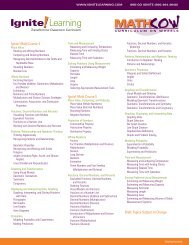The Silent Epidemic: Perspectives of High School ... - Ignite! Learning
The Silent Epidemic: Perspectives of High School ... - Ignite! Learning
The Silent Epidemic: Perspectives of High School ... - Ignite! Learning
You also want an ePaper? Increase the reach of your titles
YUMPU automatically turns print PDFs into web optimized ePapers that Google loves.
<strong>The</strong> <strong>Silent</strong> <strong>Epidemic</strong><br />
<strong>The</strong> class work in high school needs to make<br />
some connection to students’ interests and what<br />
they find relevant, especially as seven in ten said<br />
their school did not do enough to make learning<br />
interesting. One bright young woman who was a<br />
leader in her focus group said: “If they related to<br />
me more and understand that at that point in<br />
time, my life was…what I was going through,<br />
where I lived, where I came from. Who knows?<br />
That book might have been in my book bag. I<br />
might have bought a book bag and done<br />
some work.”<br />
Eighty-one percent <strong>of</strong> survey respondents<br />
said that if schools provided opportunities for<br />
real-world learning (internships, service learning<br />
projects, and other opportunities), it would have<br />
improved the students’ chances <strong>of</strong> graduating<br />
from high school. Outside studies have noted<br />
that clarifying the links between school and getting<br />
a job may convince more students to stay<br />
in school. 32<br />
Improve Instruction and Access to<br />
Supports for Struggling Students<br />
Four out <strong>of</strong> five participating dropouts (81<br />
percent) wanted better teachers and three-fourths<br />
wanted smaller classes with more individualized<br />
instruction. Over half (55 percent) felt that more<br />
needed to be done to help students with problems<br />
learning. Seventy percent <strong>of</strong> survey participants<br />
believed that more after-school tutoring, Saturday<br />
school, summer school and extra help from teachers<br />
would have enhanced their chances <strong>of</strong> staying<br />
in school.<br />
While some <strong>of</strong> the students’ best days in<br />
school were when teachers paid attention to<br />
them, many others had classes that were so big<br />
that teachers did not know their names. In our<br />
focus groups, participants repeated again and<br />
again that they believed smaller class sizes would<br />
have helped ensure that teachers maintained<br />
order in the classroom and would have provided<br />
more individual attention. <strong>The</strong> problem <strong>of</strong> large<br />
schools and the need for smaller class sizes and<br />
more personal instruction emerged more than<br />
12 separate times from the participants in our<br />
four focus groups in Philadelphia and Baltimore.<br />
Seventy-five percent <strong>of</strong> survey participants<br />
12<br />
“If they related to me more and<br />
understand that at that point in time,<br />
my life was…what I was going<br />
through, where I lived, where I came<br />
from. Who knows? That book might<br />
have been in my book bag. I might<br />
have bought a book bag and done<br />
some work.”<br />
agreed that smaller classes with more one on<br />
one teaching would have improved students’<br />
chances <strong>of</strong> graduating.<br />
<strong>The</strong>re are studies suggesting that small<br />
schools are more likely to promote the engagement<br />
<strong>of</strong> both students and staff that is so critical<br />
to reducing the number <strong>of</strong> dropouts, and that the<br />
largest direct effect appears to be in low socioeconomic<br />
status schools, 33 although there is<br />
debate about the appropriate size <strong>of</strong> such smaller<br />
schools. 34 <strong>The</strong>re is also a body <strong>of</strong> literature that<br />
reveals that small learning communities and<br />
interdisciplinary teaming are associated with<br />
lower dropout rates. 35 And there is some evidence<br />
that alternative schools serving students at risk<br />
<strong>of</strong> dropping out can also reduce dropout rates. 36<br />
Build a <strong>School</strong> Climate that<br />
Fosters Academics<br />
Seven in ten surveyed favored increasing<br />
supervision in school and more than three in five<br />
(62 percent) felt more classroom discipline was<br />
necessary. More than half (57 percent) believed<br />
their high schools did not do enough to help<br />
students feel safe from violence. Students in<br />
the focus groups talked about how they could<br />
not do homework or pay attention in class<br />
because <strong>of</strong> the many disruptions, including<br />
the fear <strong>of</strong> violence. Seven in ten (71 percent)<br />
said their schools did not do enough to make<br />
school interesting.








